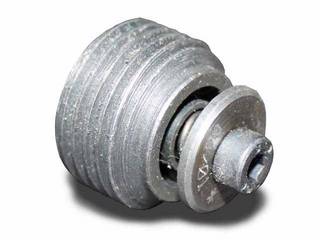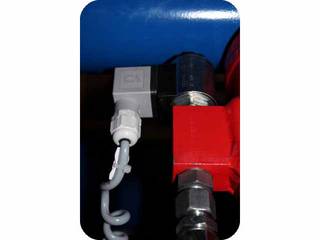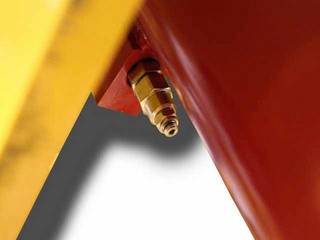A hydraulic lift table platform is held in the raised position by permanent pressure in the hydraulic cylinders. In the event a hose ruptures, this pressure would drop abruptly and the platform would drop to the ground. Three different valve types are used to prevent this: pipe rupture safety valves, electric pilot-operated valves as well as hydraulic pilot-operated valves. Here you can get more information about the design of the valves and their advantages and disadvantages.
Nowadays, safety valves are used in almost every hydraulic scissor lift scissor lift table to prevent the platform from dropping. Attention should be paid to the use of appropriate valves to prevent a possible accident, especially if there are people working or moving about around the scissor lift .
The respective application determines which type of valve is used. For example, there is a big difference between a lift table, which is only used to lift loads, and an aerial work platform where people are allowed to ride along on the platform.
How it works
The main components of a pipe rupture safety valve are the housing, the closing flap and a spring mechanism. Pipe rupture valves are screwed directly into the hydraulic cylinder and react to a pressure difference between the supply line and the cylinders of the lift table.
If the pressure in the supply line drops, the spring mechanism closes the flow-through opening. The oil cannot flow out of the hydraulic cylinders, and the platform remains in its current position.
Failure at minor leaks
However, sufficient pressure difference is necessary for the pipe rupture safety valves to effectively prevent the oil flow. This is particularly problematic if the pressure loss is not due to a burst or torn hydraulic hose, but to a small leak in the hydraulic system. The pressure difference in the event of a leak is so small that the spring mechanism does not close the flow-through opening. Consequently, the platform cannot be held securely in the top position despite the pipe rupture safety valves.
After the safety valve has been triggered
If the pipe rupture safety valves have been triggered, they can only be opened again by raising the lift table again. This action of raising the lift table allows pressure to be built up in the supply line, which opens the closing flap against the spring mechanism. For this reason, the use of pipe burst safety valves on aerial work platforms is not permitted when there is no other way to get off the platform, as the lift table platform can only be lowered once the drive has been repaired.
| Advantages | Disadvantages |
|---|---|
| Inexpensive | Do not protect against small leaks in the hydraulic circuit of the lift table |
| Low risk of failure when installed correctly and a hose or pipe ruptures | The lift table with the load remains in the raised position without any further aids until the repairs are carried out |
| Easy installation |
Electric pilot-operated valves
Electrically actuated poppet valves are provided as electric pilot-operated valves. They are installed directly on the hydraulic cylinder of the lift table. If the valves are closed and the supply line of the lift table rips off, the oil volume can be kept safely in the cylinders.
Design and mode of operation
These valves do not differ from other electrically operated 2/2-way valves. They have two switch positions, which can be adjusted by means of a coil and a spring.
Hydraulic lift tables are equipped with valves which are normally closed (NC). If no electrical voltage is applied to the operating coil, the spring presses the valve into the rest position. In this position the flow-through opening of the hydraulic valve is closed, which means no oil can be exchanged between the supply line and the cylinders of the scissor lift table. This ensures that the oil is kept safely in the cylinders in case a hose ruptures or if a pipe breaks. If the lift table needs to be moved, the operating coil is actuated, the valve opens and the platform can be raised and lowered.
Advantages over pipe rupture safety valves
Compared to pipe rupture safety valves, electric pilot-operated valves have a higher safety level. They hold the platform of the lift table safely and securely in position even if there is a small leak in the hydraulic circuit. This high level of safety is achieved by actuating or opening the valves only when a downward movement of the lift table platform is desired. In any other case, the valves are in the safe rest position. This also makes them qualified for applications with higher safety requirements.
Disadvantages of electric pilot-operated valves
But electric pilot-operated safety valves also have disadvantages too. Although installation is still very simple and flexible, it is more complex than with simple pipe burst safety valves. An additional control cable must be routed to each cylinder in the lift table to actuate the valves directly. Furthermore, the lift table's susceptibility to faults increases, as with each additional element there is a new component that can be defective. In this type of valve, the coils in particular represent an additional, albeit small, risk of failure of the scissor lift.
In addition, a lift table usually has at least two hydraulic cylinders and consequently two electric pilot-operated valves. And although it is very unlikely that both valves or coils are defective at the same time, a defective coil leads to another problem. In the event of damage, only one hydraulic valve opens while the defective valve remains closed. The entire load of the lift table therefore only acts on one cylinder and is no longer evenly distributed. For this reason, it is important when using electric pilot-operated valves, that the dimensioning of the lift table is such that one cylinder can absorb and transmit all the forces in an emergency.
The last disadvantage is the not inconsiderable cost associated with the use of electric pilot-operated valves. In addition to the additional expenditure for the installation, there is also the cost for protection against a power failure. The hydraulic valves on the cylinders only open when electrical voltage is applied. This means it is not possible to lower the lift table platform if there is a power failure. If it is absolutely necessary to lower the platform of the lift table (e.g. an aerial work platform), an uninterruptible power supply is required.
| Advantages | Disadvantages |
|---|---|
| Very safe | Protection against a power failure may be necessary |
| Also protect in case of smaller leaks (as long as the platform is not moved up or down) | More stable dimensioning of the lift table necessary |
| Relatively low installation costs | Higher probability of failure |
How it works
To prevent the lift table platform from dropping, these valves are also directly attached to the hydraulic cylinder and are closed in the rest position. By applying hydraulic pressure in the control line of the valve, the valve is opened and the oil can flow in or out of the cylinders. As the valves are only opened when the lift table is raised or lowered, even leaks do not cause any problems.
Compared to electric shut-off valves
The advantage of hydraulic pilot-operated valves over electric pilot-operated valves is the low probability of failure of the control unit. Compared to the probability of an electric coil failing, failure of the control unit of the hydraulic valve is very unlikely. As a result, the risk that one cylinder will have to carry the entire load is also very low.
Considerable installation costs
The main disadvantage of this safety feature is the associated costs. Compared to the electric pilot-operated valves, the installation cost is even higher, because not only one hydraulic line must be routed to the cylinders, but also an additional control line to each pilot-operated valve (this equals the number of installed cylinders).
Moreover, protection against voltage drop is also necessary. Hydraulic pilot-operated valves only open when the control line is pressurised. During normal operation, this is done by the built-in hydraulic power unit in the lift table. In the event of a power failure, however, the unit pack can no longer be used and the lift table platform cannot be lowered. To circumvent this problem, hand pumps or an uninterruptible power supply must be installed which enable the valves to be unlocked even in the event of a power failure. However, if the platform can remain in the top position until the power supply is restored, it is not necessary to install a hand pump.
| Advantages | Disadvantages |
|---|---|
| Very safe | High installation costs |
| Also protect in case of smaller leaks (as long as the platform is not moved up or down) | Protection against a power failure may be necessary |
| Low probability of failure |
What kind of safety feature should be chosen?
The decision for or against a certain type of safety feature cannot be made on a general basis. It depends on each individual situation on site and on the planned application of the lift table. Particularly when there are people working on or under the platform, however, care should be taken to ensure that the hydraulic system is designed for safety.
We hope that this article will give you a good overview of the special features of the various safety valves. You can take this basic knowledge with you to your lift table supplier to determine the most suitable configuration for you and to correctly assess the lift table manufacturer's suggestions.






Comments (0)
No comments found!